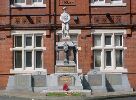
Newton-le-Willows and
Earlestown War Memorial

| OTHER WARS |
 |
Newton-le-Willows andEarlestown War Memorial |
 |
| The
Great War Roll of Honour |
|||||||||||||||||||||||||
Sydney was the son of Lindsay and Elizabeth A. Bartlett of 97,
High Street, Newton-le-Willows. His obituary in the NEG of 26th April 1918 was
brief and stated that he was a compositor at McCorquodale’s before enlisting
in the early days of the War.
He is buried in Browns
Road Military Cemetery, Festubert, in Plot IV Row A, Grave 17. Festubert
is a village 8 kilometres east-north-east of Bethune, and has given its name
to the Battle Honours of many Regiments. After the Battle of Festubert in May
1915, the sector was quiet until the Battle
of Lys began on 9th April 1918. The village was held by the 55th (West Lancashire)
Division against the German assault. The Regimental
Diary gives a flavour of the battle. The Rev. J. O. Coop gives a fuller
picture of the fighting around this time in his book “The Story of the
55th Division”, including this passage about the 11th April:
“At daybreak on the 11th the shelling of our front, support and reserve
lines was resumed, and the back areas again came in for attention. This shelling
grew into a bombardment shortly before 8 o'clock and continued with great intensity
until 11 o'clock, when an attack was launched from Loisne to the Lawe Canal,
and the centre and left of the I66th Infantry Brigade were slightly pressed
back. For a time a distinctly dangerous gap was made in our line, but a spirited
counter-attack by the 1/4th South Lancs. from Mesplaux Farm, and the 1st Northumberland
Fusiliers from Les Facons, restored the situation at a critical moment and the
danger passed.
“In the early afternoon the enemy was reported to be advancing in great
strength between Rue Cailloux and Quinque Rue, and was, moreover, reported to
be massing all along the old British line. The artillery were promptly informed
and were turned on to this concentration, inflicting such heavy casualties upon
the enemy that the attack upon the southern portion of the front of the 165th
Infantry Brigade was never able to develop. More to the north, however, the
attack was pressed home, and, after a stiff fight, and with heavy losses, the
enemy succeeded in capturing Festubert East and Cailloux Keep shortly after
4 p.m. Counter-attacks were immediately ordered and Festubert East was re-captured
without much difficulty. A stiffer resistance was expected from Cailloux and
two counter-attacks were prepared against it-the first to be delivered by troops
in the Festubert locality, and, in case of failure, a second, on a considerably
larger scale, by troops from the Brigade Reserve. The first attack, however,
did not fail, and by 7-30 p.m. Cailloux Keep was in our possession once more
and the whole of the line completely restored.”